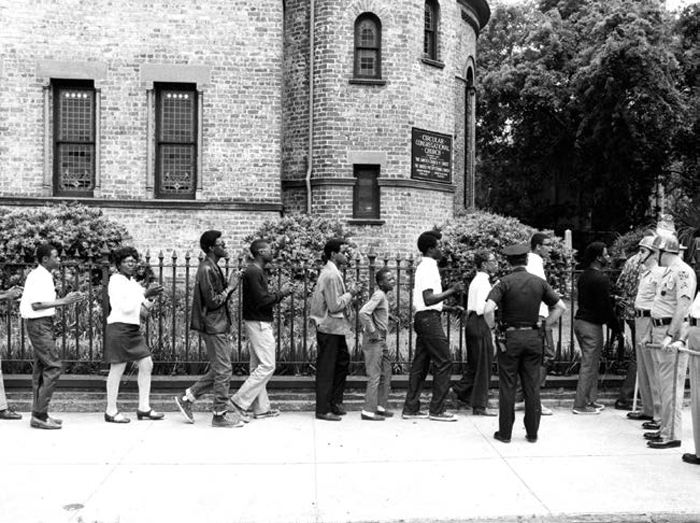An 1199 Strike That Shook Up The South
June 4, 2019

Fifty years ago, in the spring of 1959, some 450 workers at two Charleston, South Carolina, hospitals struck for more than three months for 1199 protection and recognition.
The strikers, all African American and 90 percent women, worked at the Medical College Hospital of the University of South Carolina (MCH) and at the smaller Charleston County Hospital. The strike, called by the newly-formed Local 1199B, was precipitated by the blatantly harsh treatment and the unjust firing of 12 women at MCH.
True to its history as a center of the slave trade and where secessionists fired the first shots of the Civil War, African Americans in Charleston at the time were socially and politically marginalized. Not a single Black elected official served in the state and just a few held city posts. And South Carolina was one of only two states in which less than 60 percent of eligible African Americans were registered to vote.
Employers in the state touted its low wages and low union density. The wages of at least half the Black population fell below the official poverty line. MCH workers earned a meager $1.30 an hour.
Led by one of 12 fired workers, Mary Moultrie, an MCH nurse’s aide, who had previously worked in New York City as an LPN but whose credentials MCH management refused to accept.
What distinguished the Charleston strike was the alliance of 1199 and the civil rights movement, led in Charleston by the Southern Christian Leadership Conference (SCLC), which was in the midst of its Poor People’s Campaign. SCLC was led by the Rev. Ralph Abernathy, who took the reins of the organization a year earlier following the assassination of Dr. Martin Luther King, Jr.
Although 1199 had a long history of involvement in civil rights, the Charleston campaign was the first in which it worked so closely with a civil rights organization and in which it so clearly framed the struggle as one of both union rights and civil rights. As 1199 put it, the Charleston strike was about union power and soul power.
While SCLC focused on a community-based campaign of civil disruption, 1199 took charge of member mobilization and the coordination of publicity and national labor and political support.
In addition to Rev. Abernathy, SCLC’s Andrew Young, who would later serve as Atlanta’s mayor and the U.S. ambassador to the United Nations, played a prominent role in the campaign. Local activists such as Esau Jenkins, Bill Saunders and unionist Isaiah Bennett were also key supporters. As in other civil rights campaigns, students and other young activists were indispensable. Said Moultrie, “It was the students who did the most to help us win the strike.”
But the women were at the center of the strike campaign. Moultrie, who had ties with both the traditional and more radical activists refused to be cowed. “We are sick and tired of being sick and tired,” she declared, echoing civil rights champion Fannie Lou Hamer. She and the other women were inspired by veterans such as South Carolina’s Septima Clark and Alabama’s Rosa Parks and Coretta Scott King, Dr. King’s widow and honorary chairperson of 1199’s national union. Said Mrs. King at a Charleston rally, “$1.30 an hour is not a wage, it is an insult.” She added that “the Black working woman in our nation is perhaps the most discriminated against.”
“The strike certainly raised my consciousness as a Black woman,” says Louise Brown, one of the 12 who were fired. Today, she’s active in struggles for better transportation, affordable housing, the Fight for $15 and the Poor People’s Campaign.
She was among the more than 10,000 marchers at the 1969 Mother’s Day at which more than 100 were arrested, including Rev. Abernathy and 1199 President Leon Davis.
After that the situation grew more tense. SCLC led an economic boycott of local businesses and disruptions at local stores. Demonstrations continued throughout the key business districts often in the presence of National Guard troops in riot gear and with bayoneted rifles.
Ultimately, the administration of President Richard Nixon was forced to intervene. With Andrew Young leading negotiations, an agreement was hammered out. It included the reinstatement of the 12 fired workers, a wage increases of between 30 to 70 cents an hour and a grievance procedure. But as in New York City 10 years earlier when 1199 won its hospital organizing campaign, union recognition was left unresolved.
The workers never won union recognition, but they say the strike was by no means a failure. Black workers finally began to be treated with respect, partially out of fear.
African Americans were elected to the state legislature and in the next decade Black representation in Charleston’s City Council jumped from one to six.
For 1199 nationally, the struggle helped to emphasize the important interconnections of race, class and gender. “Charleston gave birth to the movement to organize healthcare workers across the country,” says Henry Nicholas, a key 1199 organizer in Charleston and president of 1199C in Philadelphia. Management at Johns Hopkins, for example, agreed to 1199 recognition out of fear of another Charleston.
“I have no regrets,” says Naomi White, a Charleston striker. We changed things at the hospital and today younger people are taking over.”
One of those younger activists is Millicent Traeye Middleton, the daughter of striker Hermina B. Traeye after whom a nursing home on St. John’s Island was named. Middleton, the youngest of Hermina Traeye’s nine children, has been working to complete her mother’s tasks. “Today, too many have lost their way and are looking for something to hold onto,” Middleton says. She is a former pastor and the coordinator of South Carolina’s Sea Island Democrats.
One of her sisters, Wilma Drayton, recalls being hauled onto a bus and being detained in a stadium for participating in a youth demonstration during the strike. “Our mother taught us to judge people on their character,” she says. “She never taught us to hate.”
Says Middleton, “The race is not finished, but we are picking up the baton and running with it.”
- 1199 Magazine: May / June 2019

